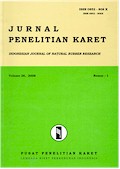| Journal Article |
 |
|
| Article Title | Pertumbuhan Karet (Hevea brasiliensis) dalam Sistem Monokultur dan Campuran dengan Akasia (Acacia mangium). Studi Kasus di Sembawa, Sumatra Selatan: I. Pengukuran Status Air dan Lingkungan Radiasi | | Author | Ni'matul Khasanah, Thomas Wijaya, Tania June, Gregoire Vincent, Meine van Noordwijk and Gede Wibawa | | Year | 2008 | | Journal Title | Jurnal Penelitian Karet | | Institution | Balai Penelitian Sungei Putih, Pusat Penelitian Karet Indonesia | | Volume | 26 | | Issue | 1 | | Pages | 31-48 | | Call Number | JA0339-09 | | Keywords | Hevea brasiliensis, Acacia mangium, intercrop systems, leaf water potential, light intercepted by canopy, light use efficiency, tree growth | | Notes | ISSN 0852 - 808 X |
|
| Abstract: |
| Interplanting of Acacia mangium within Hevea brasiliensis may be an attractive option for smallholder rubber farmers in the tropics to increase their land productivity. Indeed, economic prospects for timber are good as timber resource of the natural forest has become seriously depleted and particularly so in Sumatra where this study has been conducted. Being a very fast growing tree species, spacing arrangement are probably required to reduce light competition with rubber trees. Competition for water use between tree species in period of low rainfall may be another constraint for the growth of the rubber tree. A large portion of rubber planted area in Indonesia is subject to two or more dry months during which rubber may shed its leaves and stop its growth. This study compared a series of growth and physiological parameters measured on rubber and A. mangium trees either in monoculture or mixed system. Rubber trees grown in monoculture had two levels of tree spacing, 6 m x 3.3 m and (6 x 2) m x 14 m while A. mangium had one level, 3 m x 3 m. Rubber trees and A. mangium grown in mixed systems had tree spacing, (6 x 2) m x 14 m and (3 x 3) m x 17 m, respectively. In the fifth year after plot establishment, variation in the growth of rubber was analyzed in relation to leaf water potential (LWP), light interception by canopy, biomass and light use efficiency (LUE). LWP was used not only as an indicator of plant water status, but also as indicator of competitive strength. Pre-dawn LWP of rubber showed significant differences between rainy and dry season. LWP of A. mangium is lower than rubber.
However, LWP of rubber under different systems studied did not show any consistent difference. On the other hand, even though there was no significant difference between LUE of rubber trees in mixed systems and in monoculture systems, the biomass of rubber trees and light interception of rubber in mixed systems were significantly smaller than those of monoculture systems. Thus, the net effect of A. mangium on depressing rubber growth was likely to be primarily caused by shading. |
|
|
Download file(s): Click icon to download/open file.
|
| |
File Size |
Description |

|
19 KB |
Abstract |

|
- |
URL |
|
|
GRP 2: Maximizing on-farm productivity of trees and agroforestry systems
|
| Viewed in 2130 times. Downloaded in 271 times. |